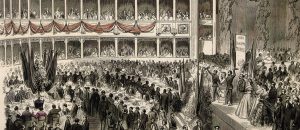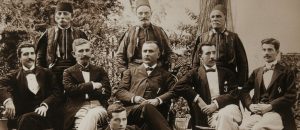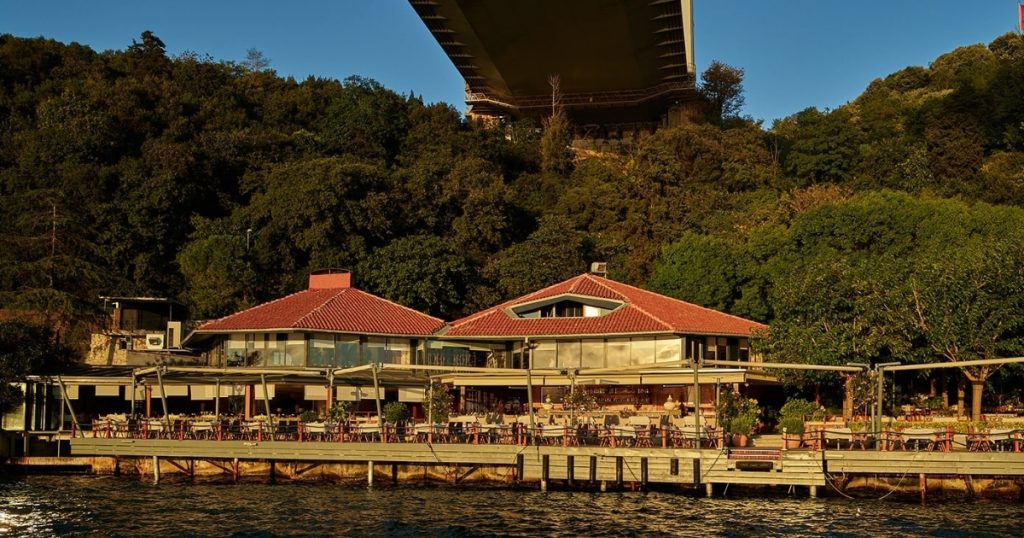The clatter of forks and knives echoing in the dining halls of Dolmabahçe Palace is the clearest melody of the revolution in Ottoman table manners and eating habits that had persisted for centuries. At Dolmabahçe, the communal dining style of Topkapı Palace, where meals were eaten by hand or with a spoon around large trays called sinis placed on the floor, was replaced by high tables, chairs, individual porcelain plates, and European-style cutlery sets. This change was not merely a shift in etiquette, but a reflection of a profound transformation in mentality regarding individualism, hygiene, and the understanding of international diplomacy, all manifested in table manners. [Link: Life and culture in Dolmabahçe -> /learn/life-and-culture-in-the-palace]
Dining at Topkapı: The Communal Spirit Around the “Sini”
The traditional dining arrangement at Topkapı Palace reflected a communal, community-focused food culture.
- Venue and Seating: Meals were eaten around large, round metal trays called “sinis,” placed on cloths spread on the floor. People would sit cross-legged or kneel around these trays.
- Service: Dishes were placed in the center of the sini in large platters and bowls, and everyone ate from the same container. The concept of a personal plate did not exist.
- Manner of Eating: Solid foods like rice and meat were eaten using the three fingers of the right hand. For soups and stews, there were shared spoons. Forks and knives were not used.
- Social Meaning: While this table reflected hierarchy (the Sultan ate alone), it was also a ritual of unity and abundance where members of a community shared the same food.
Revolution at Dolmabahçe: Individualism and Protocol at the “Table”
Dolmabahçe Palace dismantled this communal dining tradition, replacing it with a European-style table setting (etiquette) that centered on the individual and strict protocol. The key elements of this revolution were:
- Table and Chair: Meals were now eaten at high wooden tables while seated on chairs. This was not just a physical change but a symbol of a new posture considered more individualistic and “civilized.”
- Individual Service: In front of each person were placed [Link: porcelain plates, crystal goblets, and silver cutlery sets -> /sultan-sofrasinin-zarafeti-paris-sikligini-dolmabahceye-tasiyan-sevres-ve-baccarat-yemek-takimlari] from Europe’s most prestigious brands (Sèvres, Baccarat). Everyone had their own plate, their own fork, their own glass. This was an indicator of the rising importance of the individual, as well as a change in the understanding of hygiene.
- Use of Fork, Knife, and Spoon: The custom of eating by hand was completely abandoned. The complex European dining protocol, which required using a different fork, knife, or spoon for each type of dish, was adopted. The palace household, and especially the princes, took special lessons to learn these new rules.
- Menu and Order of Service: Food was no longer piled in the middle but served individually in a specific order (soup, appetizer, main course, salad, dessert, fruit) in the French “service à la russe” style.
The Dining Table as a Diplomatic Tool
The most important reason for this revolution in table manners at Dolmabahçe was diplomacy. When hosting European ambassadors and heads of state at the palace, Sultans Abdülmecid and Abdülaziz wanted to prove that the Ottomans were just as “civilized” and sophisticated as they were. During a [Link: state visit hosting a foreign guest -> /elciler-ve-imparatorlar-dolmabahce-sarayinda-bir-devlet-ziyareti-protokolu-nasil-islerdi], the Sultan dining at the same table with his guests according to the same rules was a powerful diplomatic act that sent the message, “We are a part of your world.” A Sultan sitting cross-legged around a sini was an “exotic” and “backward” figure in the eyes of a European ambassador; whereas a Sultan sitting at a table in his frock coat, using a fork and knife, was an equal sovereign to be taken seriously.
The Reflection of Mentality at the Dining Table
In conclusion, the change that took place at the Dolmabahçe Palace dining table carries a much deeper meaning than the mere use of a fork and knife. It is the most intimate and flavorful expression of the Ottoman transition from a centuries-old communal and traditional lifestyle to a modern mentality that emphasized the individual and international norms. The shift from the sini to the table, from the hand to the fork, was a revolution that fundamentally changed not only the way an empire ate, but also the way it perceived itself and its place in the world.



















